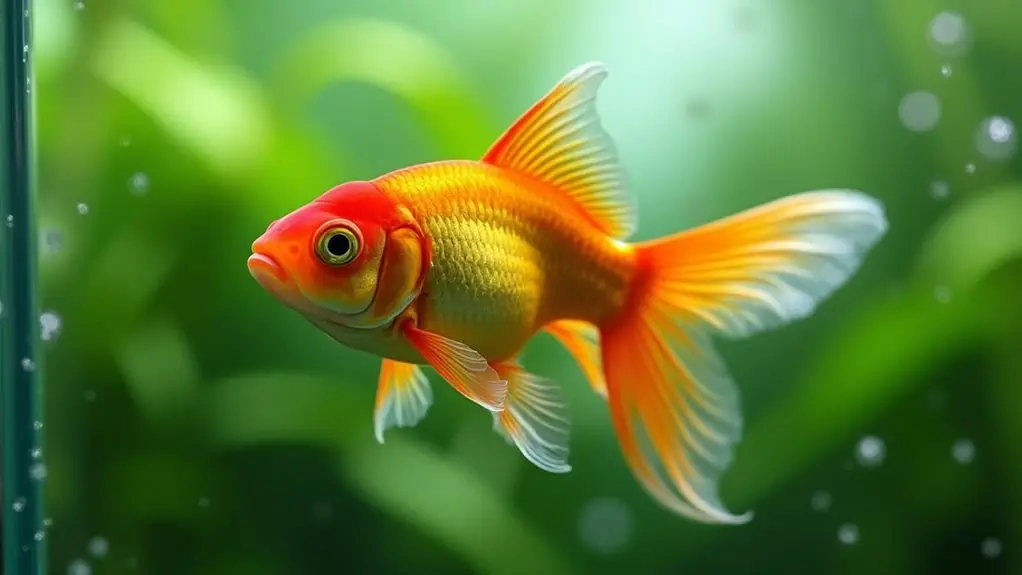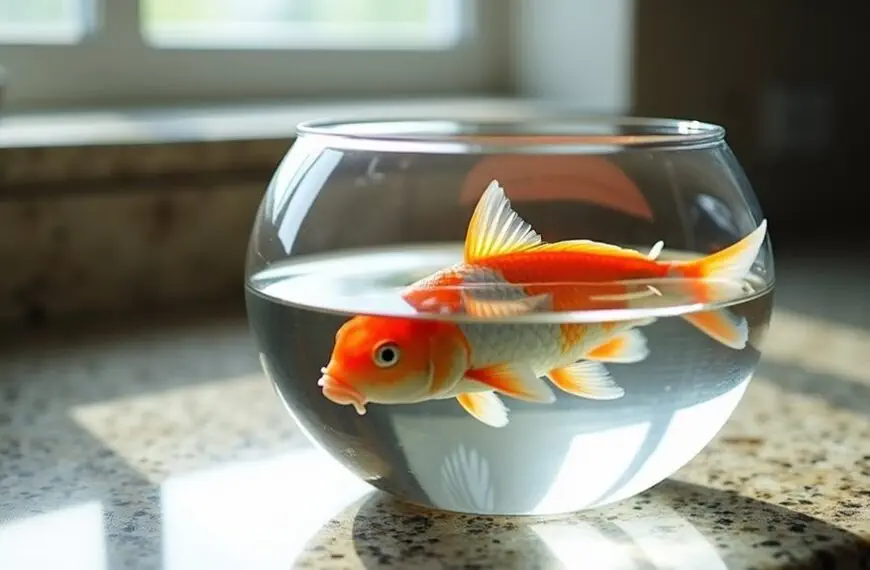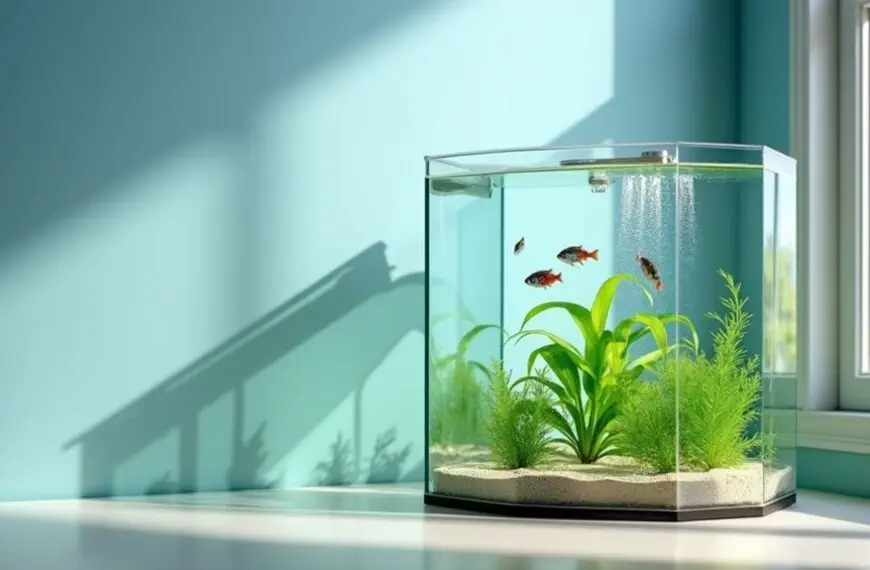If you're just starting your aquarium journey, you'll find several hardy fish species that are perfect for beginners. Tetras, rasboras, and danios are incredibly resilient and adaptable to varied water conditions, making them excellent first-time choices. Guppies and platies bring vibrant colors to your tank while staying relatively low-maintenance. Betta fish offer personality plus and can actually recognize their owners, while peaceful Cory catfish help keep your tank clean as bottom dwellers. For the best success, start with a 20-gallon tank, which gives your fish plenty of room to thrive and helps maintain stable water conditions. There's so much more to discover about these fascinating underwater companions.
Contents
Selecting Your First Aquarium Fish
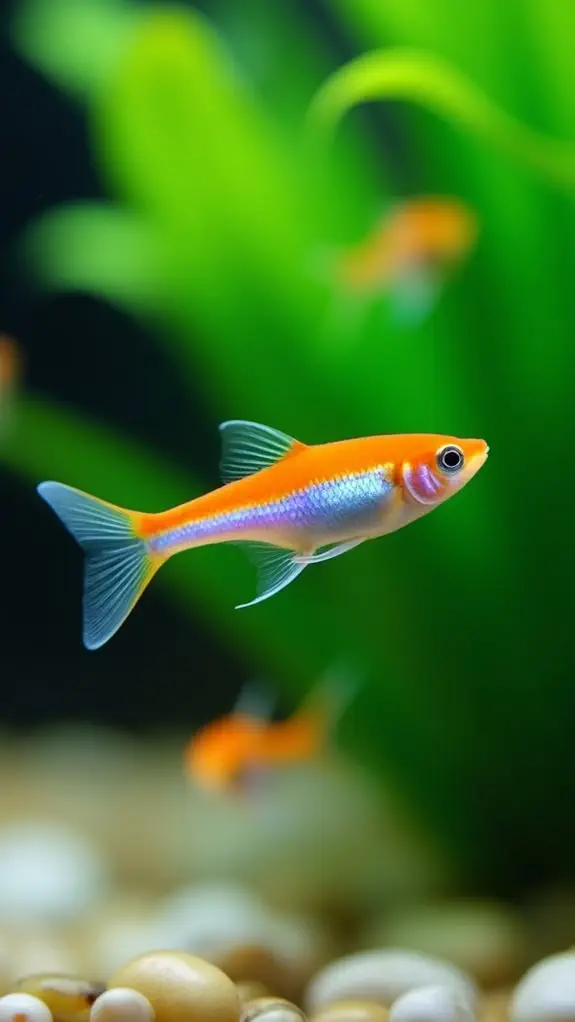
Choosing your first aquarium fish can seem overwhelming with over 3,000 species available in the trade. That's why it's essential to do your homework before you start picking out those eye-catching swimmers for your tank.
While it's tempting to select fish based on their stunning colors or unique patterns, there's much more to take into account for a successful aquarium. Beginners often find success with live-bearing fish species, which thrive in a standard 10-gallon starter tank. Many new aquarists achieve great results with hardy cypriniform species that adapt well to various water conditions, particularly in peaceful community tanks that foster harmony among different species.
Start by researching fish compatibility and the specific needs of different species. You'll want to know if your potential finned friends are schooling fish that need companions or solitary swimmers who prefer their own space.
Don't forget to take into account their dietary needs – some fish are picky eaters, while others will happily munch on standard fish flakes.
You'll also need to reflect on tank size, water conditions, and how much time you can dedicate to their care.
Species Perfect For Novice Hobbyists
Starting your aquarium journey becomes easier when you select from a group of proven, hardy fish species. When it comes to beginner fish, you'll want to take into account delightful companions like tetras, rasboras, and danios, which aren't just beautiful but also remarkably resilient. These fish are like the straight-A students of the aquarium world – they're well-behaved and adaptable! A quality filter system is essential for maintaining optimal water conditions. Regular water testing and changes are vital for maintaining their health and happiness.
Choosing fish that thrive in community settings promotes ideal community dynamics, enhancing the overall enjoyment of your aquarium. Fish compatibility is essential for your success, and you'll find that guppies and platies make wonderful starter fish. They're colorful, friendly, and won't give you a headache with complex care requirements.
If you're looking for something with personality, think about a betta fish – they're like the puppies of the fish world, recognizing their owners and showing off their stunning fins. Don't forget about the cleanup crew! Cory catfish are excellent bottom dwellers that'll help keep your tank tidy while adding interest to your aquatic community.
Remember to keep similar species together and provide appropriate tank sizes – your fish will thank you by thriving and showing their best colors. With these beginner-friendly options, you're well on your way to becoming a successful aquarist!
Tank Size And Requirements
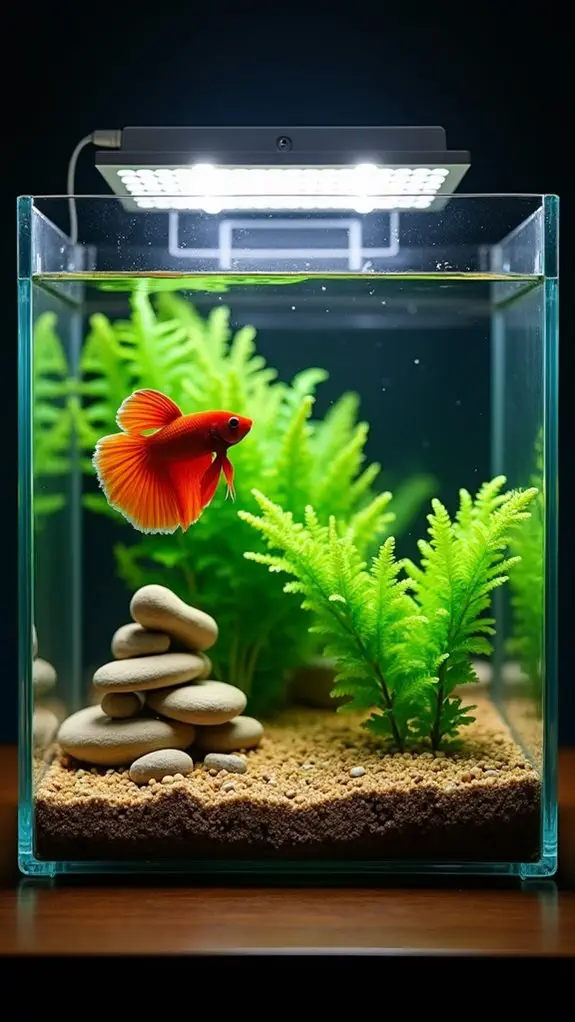
One of the most essential decisions you'll make as a new aquarist is selecting the right tank size. While you might be tempted to start small, a 20-gallon tank is actually your best bet for success. It's like giving yourself a safety net – larger tanks are more forgiving when it comes to water quality and fish compatibility issues. Regular testing bi-weekly will help maintain optimal conditions, as this ensures the health of your fish remains a priority throughout your aquaristic journey.
If you're planning to keep schooling fish, you'll want to take into account a 20-40 gallon setup. This size gives your finned friends plenty of room to swim and socialize (yes, fish are social butterflies too!). Peaceful fish species like tetras and danios make excellent starter choices.
For those eyeing mid-sized species like cory catfish or loaches, a 40-60 gallon tank would be perfect. Remember, tank maintenance becomes less frequent but more thorough as the size increases.
Think of it this way: smaller tanks are like studio apartments – they're cozy but require constant cleaning and organizing. Larger tanks are more like spacious homes where everyone has room to breathe.
The general rule is one gallon per inch of fish, but don't forget that some species need extra space to thrive. Your fish will thank you for giving them a roomy home!
Building A Balanced Fish Community
Now that you've got the right tank size, building a thriving fish community requires careful planning and research. Understanding community dynamics is essential, as not all fish play nicely together – think of it like creating the perfect guest list for a party!
When selecting compatible species, start with peaceful fish like Tetras, Rasboras, or Platies. These friendly swimmers make excellent community members and won't cause drama in your aquatic neighborhood. A proper quarantine period helps ensure your new fish don't introduce diseases to the community. Adding water quality tests regularly is crucial since fish like Neon Tetras are sensitive to poor conditions. It's also important to keep in mind that different species have unique care requirements which can affect their compatibility.
Remember to keep schooling fish in groups of six or more – they're social butterflies who get stressed when they're lonely.
Watch out for potential troublemakers like male Bettas or Mollies, who can sometimes act like tiny underwater bullies. You'll want to balance your tank's population by mixing different species that occupy different areas of the tank.
For example, combine mid-water swimmers like Tetras with bottom-dwellers like Cory Catfish. Incorporating a variety of species that complement each other's behavior can greatly enhance the overall health of your aquarium.
Don't forget to provide plenty of hiding spots and plants for your fish to explore and retreat to when they need some alone time.
Keep an eye on your underwater community and be ready to make adjustments if you notice any signs of aggression or stress.
Common Aquarium Care Mistakes
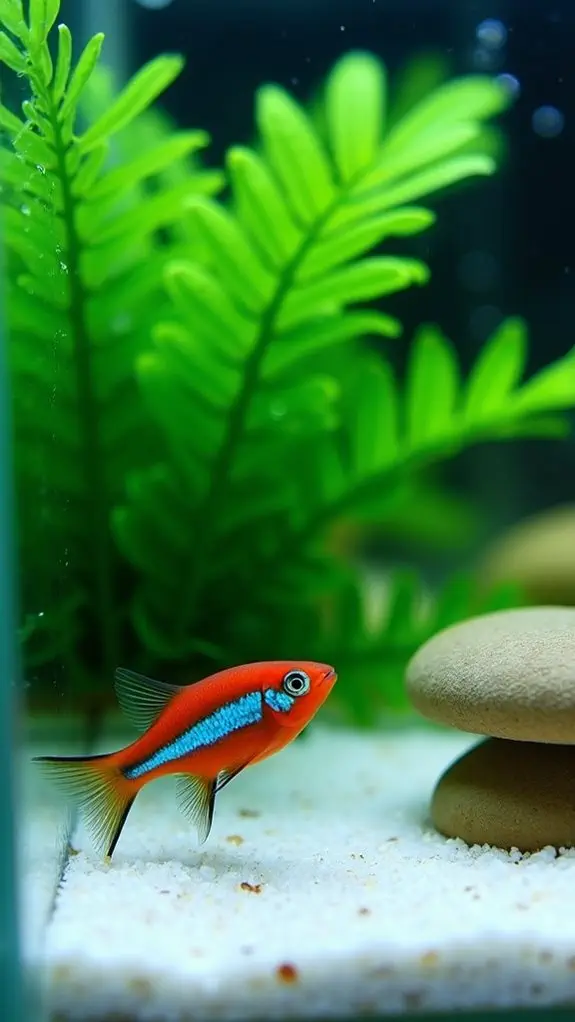
You'll want to watch out for three big mistakes that can throw off your aquarium's balance: overfeeding your fish (they don't need three meals a day), choosing a tank that's too small (bigger is actually easier to maintain), and skipping regular water tests.
While these might seem like small issues, they're actually the most common reasons why beginner aquarists run into trouble with their first tank setup. Consistent maintenance of your tank prevents many potential problems from developing over time.
Common goldfish require 30 gallons per fish to thrive, so don't make the mistake of keeping them in small bowls. Additionally, remember that stability in water parameters is essential to prevent stress and health issues for your fish.
Just like you wouldn't skip oil changes for your car, you'll need to stay on top of these basics to keep your underwater friends happy and healthy.
Overfeeding Your Fish Daily
A feeding frenzy is one of the most common mistakes new aquarists make when caring for their fish.
While it's tempting to shower your underwater friends with food every time they swim up to greet you, overfeeding consequences can be severe. You'll notice uneaten food collecting at the bottom of your tank, and before you know it, your crystal-clear water turns cloudy and green with algae.
To keep your aquatic pets healthy, you'll need to establish a proper feeding schedule.
Don't let those begging fish fool you – they're opportunistic eaters who'll gladly consume more than they need! Instead, follow the 3-minute rule: only feed what your fish can eat within three minutes, and remove any leftover food.
If you're seeing bloated fish or a sudden explosion of algae, you're probably being too generous with portions. Overfeeding significantly impacts water quality by increasing waste buildup in the tank, contributing to toxic ammonia levels.
Tank Size Too Small
Selecting the right tank size stands as one of the most critical decisions for new fish owners. You might be tempted to start small, but tank size recommendations exist for good reasons. A tank that's too small can create serious problems for your finned friends, and you'll want to avoid these small tank consequences from the start.
When you're planning your aquarium, remember that most fish need more space than you'd think. If you're considering fancy goldfish, you'll need at least a 20-gallon tank, while common goldfish require a whopping 30 gallons each!
For tropical fish, think about providing 1.5-2 liters of water for every centimeter of fish length – and don't forget to exclude those flowing tails when measuring.
Here's why size matters: smaller tanks are like tiny apartments with poor ventilation. They're prone to rapid pH changes, waste buildup, and oxygen depletion that can stress out your fish. Furthermore, the wrong tank size can lead to poor water quality, ultimately impacting the health and well-being of your aquatic pets.
Plus, your fish need room to swim, explore, and live their best lives. Trust us, you don't want to be the landlord of an overcrowded fish condo – it never ends well!
Poor Water Testing Habits
Regularly testing your aquarium water remains one of the most overlooked yet essential aspects of fish care. You wouldn't want to live in a polluted environment, and neither do your fish!
Maintaining proper water quality through consistent testing can mean the difference between thriving fish and constant health issues. When you're new to the hobby, it's easy to skip water testing or rely on visual cues alone, but this approach often leads to problems.
Here's what you'll need to focus on for effective water testing:
- Test your water parameters at least once a week, even when everything looks fine.
- Always use fresh testing supplies and check expiration dates on your test kits.
- Follow instructions precisely, paying attention to proper measurement amounts.
- Keep a logbook to track changes in water parameters over time.
- Clean your testing equipment thoroughly between uses.
- Regular testing helps prevent toxic buildup of ammonia and nitrite levels, which can seriously harm your fish.
Don't wait until your fish show signs of stress to check your water quality.
By establishing a regular testing frequency and maintaining accurate records, you'll create a healthier environment for your aquatic friends.
Daily Fish Care Schedule
You'll want to start your daily fish care routine with a morning feeding and quick visual inspection of your aquarium's inhabitants.
During the evening hours, it's ideal to test your water quality and guarantee all equipment is running smoothly. Regular water changes can further improve water quality and overall fish health by reducing ammonia and nitrites.
These simple daily checks, which only take a few minutes, will help you spot potential problems before they become serious issues for your finned friends.
Morning Feeding and Check
Starting your day with a proper morning fish care routine sets the foundation for a healthy aquarium. When you're still sipping your first cup of coffee, you'll want to check that all your equipment is running smoothly.
It's like giving your underwater friends their morning wellness check – making sure filters are humming along, lights are bright, and the heater's keeping things cozy.
During your morning routine, you'll need to feed your fish and watch how they respond to breakfast. You're not just tossing in food; you're observing their behavior and making sure everyone's swimming happily.
After they've finished eating, don't forget to remove any leftover food to keep the water clean. Maintaining regular water changes is also crucial for enhancing overall water quality.
Here's your essential morning equipment check list:
- Check that your filter's running at full strength
- Verify all lights are working properly
- Monitor water temperature
- Top off the tank with treated water if needed
- Look for any unusual equipment sounds or behavior
Evening Water Testing
While your morning routine focuses on feeding and equipment checks, evening water testing plays an equally essential role in maintaining a healthy aquarium.
You'll want to make evening testing a consistent habit, as it helps you spot potential problems before they become serious issues. Think of it as giving your fish's home a quick health check-up!
During your evening testing routine, you'll need to focus on critical water parameters like pH and alkalinity. If you've got a reef tank, you'll also want to keep tabs on calcium and magnesium levels, especially if you're dosing these supplements.
Don't worry if it seems overwhelming at first – you'll get the hang of it quickly! Start with the basics, like pH testing, which you should do at the same time each evening for the most accurate results.
Remember to follow the test kit instructions carefully and avoid taking samples near filters or any debris. It's like following a recipe – precision matters!
Keep a simple log of your readings, and you'll start noticing patterns that'll help you maintain ideal conditions for your fishy friends.
Frequently Asked Questions
How Long Can Fish Survive if the Power Goes Out?
Your fish can typically survive a power outage for about 2 hours, but proper emergency preparedness can extend this time. You'll need to focus on maintaining oxygen levels and temperature control for longer survival periods.
Can Aquarium Fish Recognize Their Owners?
Yes, your fish can recognize you! Studies show fish behavior includes owner recognition, allowing them to distinguish their caretakers from strangers. They'll often swim to the front when you approach their tank for feeding.
Why Do Some Fish Change Colors After Being Purchased?
Your fish's color changes after purchase can be due to stress response from the new environment, natural color adaptation to different lighting, or changes in diet. Don't worry – it's often normal behavior.
Should I Quarantine New Fish Before Adding Them to My Aquarium?
Yes, you should always quarantine new fish. It's essential for fish health, preventing disease spread to your main tank. You'll see major benefits like reduced mortality rates and easier treatment if problems arise.
How Can I Tell if My Fish Are Male or Female?
You can identify your fish's sex by observing physical traits and breeding behavior. Look for differences in color brightness, fin shape, body size, and specific features like males' longer fins or females' rounder bodies.
Final Thoughts
Starting your aquarium journey doesn't have to be complicated. You'll find success with hardy fish like bettas, guppies, or tetras while learning the basics of fishkeeping. Remember to cycle your tank, maintain regular cleaning schedules, and resist the urge to overstock. By choosing beginner-friendly species and following proper care guidelines, you'll create a thriving underwater community that brings joy and relaxation to your home for years to come.

